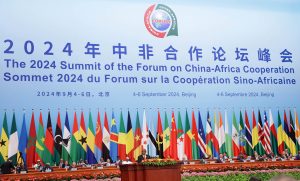In his opening speech at the Forum on China-Africa Cooperation (FOCAC) summit on September 5, Chinese President Xi Jinping remarked, “China and Africa’s joint pursuit of modernization will set off a wave of modernization in the Global South and open a new chapter in our drive for a community with a shared future for mankind.” According to Xi, this joint path to modernization would be distinct from the Western model, which “has inflicted immense sufferings on developing countries.”
However, Beijing’s pitch to jointly pursue modernization with African countries comes at a time when China is reducing loans and investments in Africa and facing growing scrutiny from recipient countries about the viability of Chinese-led projects. According to Boston University’s Global China Initiative, the value of Chinese loans in 2023 ($4.6 billion) was just a fraction of the amount given in 2016 ($28.4 billion). Hence, Xi’s call for a modernization partnership indicates a change in gears, with Beijing seeking to compensate for less financial firepower by focusing more on governance and capacity building. It signals a shift in China’s Global South strategy, which has matured in tandem with changing domestic priorities and international environment.
Any type of response or alternative engagement – including by an India that seeks to be the voice of the Global South – must therefore first appreciate the conceptual definition of “modernization” from a Chinese perspective.
Chinese-style modernization (中国式现代化) first prominently appeared in the ideological parlance of the Chinese Communist Party (CCP) in 2021 in the important resolution on CCP history issued by the Sixth Plenum of the 19th Central Committee. The phrase has since been incorporated as a key component of the Xi Jinping Thought. Its messaging is both inward-looking and outward-facing. Domestically, it asserts the centrality of the CCP’s rule and a new form of “high quality development” that focuses on boosting domestic demand, technologically advanced industries, ecological protection, and creating a more equitable society.
The external messaging has become consolidated in the Global Civilization Initiative, Global Development Initiative and Global Security Initiative. It involves four main tenets.
First, Chinese-style modernization is hinged on economic globalization and openness. China has benefited significantly from the open trade, market access, and investments under the U.S.-led Western institutions. In the last decade, Chinese leaders have repeatedly spoken against the ongoing wave of economic nationalism and deglobalization. However, this is not a call to go back to the neoliberal withdrawal of the state. In China’s vision, globalization is rather to be guided by a strong state that enjoys an upper hand over both market forces and international institutions. From the Chinese side as well, it is the party-state, and not the private sector, that is the face of China’s outreach.
Second, Chinese-style modernization challenges the notion of modernization being akin to Westernization and offers an alternative to the developing world. Portraying colonial exploitation in Africa and China’s “century of humiliation” as “the historical injustices of the modernization process,” Xi argued for a joint pursuit of modernization built on a relationship of equality, sincerity, and amity. This has two visible manifestations: first, an insistence on non-interference in domestic political affairs even as China develops relations across ideological and political spectrums; and second, instead of conditional loans and adjustment programs, a focus on training and sharing governance strategies. This is aimed at shaping governance systems in China’s own image and increasing the legitimacy of the Communist regime in China. For example, at FOCAC, Xi pledged training programs in fields like law making, agriculture, scientific innovation, epidemic response, policing and law enforcement.
The third important feature of Chinese-style modernization is the “mutual reinforcement of high-quality development and greater security.” China asserts the superiority of its model in achieving the “rare” feat of a high level of economic development and social stability in a much shorter span of time than the West. Hence, the joint path to modernization is to be accompanied by China sharing its experience in party and state governance and helping countries to improve capacity in safeguarding peace and stability “independently.” China has also pledged military assistance grants, joint military exercises, as well as personnel exchange and training for its partners in the Global South, which will also help ensure the safety of Chinese projects overseas.
Finally, Chinese-style modernization incorporates lessons from the early years of the Belt and Road Initiative as well as China’s own rapid development. While infrastructure investments, mining, and resource extraction remain at the heart of Chinese outreach in Africa, Xi spoke of projects that are “small and beautiful” and adhere to “people centric development.” Thus, China-Africa joint modernization is likely to include developing small and medium enterprises, generating employment, boosting health capacity, cooperation in disaster prevention, and biodiversity conservation for green development. Commitments to each of these, backed by financial support, from the top leadership signify their critical status in China’s strategy.
Learning from the experiences of other great powers and its own missteps, China is shifting gears toward a more comprehensive and long-term strategy in its Global South diplomacy. This strategy goes beyond material facets to build political alignment and societal goodwill for China in the developing world and bolster its image as the norm-setter and leader of the Global South. For India, this is an important moment to assess the evolving situation and formulate its own unique narrative.

































